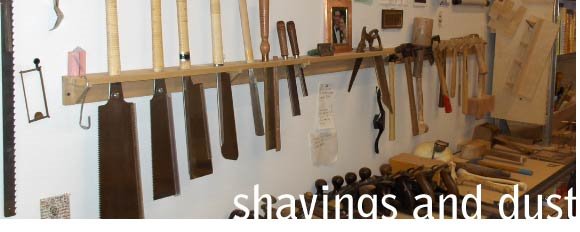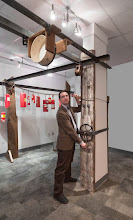Which of course gets my juices going.
Japanese steel work is legendary in the world of tools and tool makers. Their chisels and plane irons are exceptionally fine, and I already own a couple of Japanese chisels and a Japanese plane. But of course acquiring a few more was high on my list while I am here.
 Unfortunately, there are no chisel makers still working within Kyoto anymore. So I can't go visit a blacksmith, which is something I was hoping to do. I did some poking around, though, and found a genial if taciturn sixty-something man named Shigaharu-san. He was not easy for someone from out of town to find. Though his store is on one of the big north-south thoroughfares here in town (think 6th Ave in NYC), he has no website or web presence of any kind. He does not take credit cards and I do not think he even has a phone line. I found out about him on a blog about kitchen knives, and I went to visit him.
Unfortunately, there are no chisel makers still working within Kyoto anymore. So I can't go visit a blacksmith, which is something I was hoping to do. I did some poking around, though, and found a genial if taciturn sixty-something man named Shigaharu-san. He was not easy for someone from out of town to find. Though his store is on one of the big north-south thoroughfares here in town (think 6th Ave in NYC), he has no website or web presence of any kind. He does not take credit cards and I do not think he even has a phone line. I found out about him on a blog about kitchen knives, and I went to visit him.A lot of the little owner-operated shops in town have only the one person in them and are small. Some are barely fifteen feet deep and maybe twenty feet wide if that. As I can not read kanji or kana it is not uncommon for me to poke my head into a shop and look around and have absolutely no idea what it is that they sell. Figuring this out is complicated by the habit here of using the shop as a place to store things that the owner can't fit anywhere else. So there might be a bike shoved over to the side, a couple of boxes stacked in the corner, maybe a paper shopping bag with clothes spilling out. I am certain that this is a holdover from a time when the shop keepers lived behind or above their stores, so that using it as overflow storage made sense. Actually, I am pretty sure that many of them still do. It looks strange to Western eyes, we have different ideas about what a store should look like, but here it is pretty normal.
Shigeharu-san's shop is different, though, and it was clear as soon as I walked in what he sold. He asked me not to take photos inside, but there were two glass fronted display cases to the right, one filled with rows and rows of knives and the other with planes and chisels. To the left was another case filled with knives and above that a full set of very fine knives in a frame hung on the wall. The shop is a bit dim, and has the feeling of a place that was linoleumed and painted about thirty years ago and has not been updated since then. There was no sign of anyone when I walked in, which is again typical.
So I looked around a little, and finally called through the curtained doorway "sumimasen," a word that means "excuse me," "sorry," "thank you," "welcome," and is used in just about every sentence. It seems to be a verbal Swiss army knife, it indicates politeness and gratitude and a general willingness to be engaged with whomever you are talking to. The waiters say it when you walk into a restaurant, a person who wants to ride their bike past you will call it out, and when you walk into a shop and there is no one there it is what you holler into the back.
Shigaharu-san came out, wearing a dust mask and taking off a pair of black-stained gloves. He had been grinding knives in the back, you see. I used the only other Japanese word that I know, "Nomi," which means "chisel." He pointed me to the case full of them, and I poked around a little. I asked if they were hand made, but he looked at me quizzically. Then he went over to the cash register and picked up a much-thumbed phrasebook and handed it to me with the air of someone who regularly has to have conversations in a language he does not know. I paged through to find "hand made" (tetzukuri) and then pointed at the chisels.
In pantomime and pidgin he explained that it was in fact handmade but down in Osaka, not here in Kyoto. No one is making them in Kyoto anymore, he said. I selected two of them, and then turned to the knives, indicating that the chisels were for me but that my wife is a great cook and would like a knife. So I asked about the knives. "Tetzukuri?" He looked at me with a great deal of patience. "Hai." And then he pointed to himself. He made the knives there, in that shop in the back. He is, it turns out, the last person still making knives in the city of Kyoto. In fact, that is what he had been busy doing, thank you very much, when I came in and started asking questions. He turned the blade of one knife over and pointed and the engraving on the side and read it to me: "Shiga-Haru," he said as he ran a finger black with steel dust along the back edge of the knife. Then he pointed again at himself just to make sure this gaijin got the point.
I got the point.
I asked if I could photograph him and the shop, but he demurred, clearly wanting to get back to work and not feeling terribly much like humoring me in that regard. I don't blame him. Little bit of a weird questions, I guess.
So two chisels and a knife later I was back on the street. It is a lovely knife, and when we use it in the kitchen I will think about Shigaharu-san, and hope that if he does have to deal with too many meddlesome tourists asking questions that at the very least they appreciate his knives enough to buy them and keep the last knife maker in Kyoto in business.
 |
| Some tools in the window of the shop. That curved blade in the center is a predecessor to what became the hand plane. |
 |
| The santoku I bought. |
 |
| The top two characters say that it was made here, I think. The bottom two are Shigaharu's name. |


1 comment:
Your posts are a pleasure; well written and informative. I would like to show you some of my (great) grandfather's barn building tools when you get back. Gosh, I can even play a tune with you.
Post a Comment